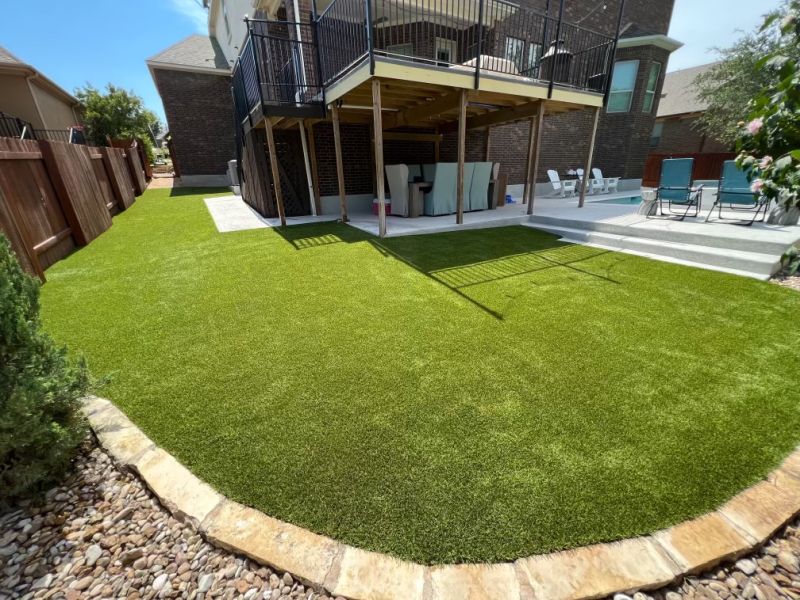Artificial Turf vs. Sod: Can Each Make Excellent Lawn Options?
Lawn maintenance is hard work, and here in Texas, it can often be for naught as your grass suffers under drought and extreme heat. When this happens, many homeowners start to evaluate their options, and we’re often asked about whether artificial turf or sod make for a better choice.
At Highland Lakes Outdoor Living, we use both artificial turf and grass varieties as well as sod for various purposes to bring backyard projects together. Each has its own role to play, and deciding between the two comes down to your priorities.
Let’s see how these options stack up when it comes to aesthetics, maintenance, cost, and environmental footprint.

Artificial Grass (turf)
Artificial grass, or turf, is one of the top options homeowners choose when looking to completely eliminate maintenance needs vs. the requirements of sod or natural grass. When installed for this reason, turf makes a lot of sense, as there’s very little maintenance required at all. Here are the advantages and disadvantages of using turf in your backyard
Pros:
-
Low Maintenance: Unlike natural grass, artificial turf doesn’t require mowing, watering, or fertilizing, making it an appealing option for busy households.
-
Durable: High-quality artificial turf can withstand heavy foot traffic and play, maintaining its integrity and appearance over the years. Additionally, newer turf varieties are designed to be softer and safer, reducing the risk of injuries during playtime.
-
Water Conservation: It eliminates the need for water, pesticides, and fertilizers used in maintaining natural grass.
-
Allergen-Free: No pollen production. And it eliminates the mud and mess that can come with natural grass, especially in rainy seasons. This means cleaner play areas for kids and pets and a reduction in pests like ticks and fleas that thrive in natural lawns
Cons:
-
High Initial Cost: Initial installation costs for artificial turf can be high, but the savings on water bills, lawn care services, and maintenance supplies can offset these expenses over time.
-
Heat Retention: Artificial turf can become hot to the touch in direct sunlight, potentially uncomfortable or harmful to children and pets during peak summer months.
-
Environmental Concerns: Concerns have been raised about the chemicals and materials used in some artificial turfs, including the potential exposure to lead or the inhalation of crumb rubber particles. Opting for turf certified as free of toxic materials is crucial for ensuring a safe play environment.
-
Lacks Natural Look/Feel: Depending on the type of turf and its infill, the surface can be abrasive, posing a risk of scrapes and burns during falls or rough play. Choosing a softer variety and proper infill can mitigate this issue.
Sod
If your lawn isn’t looking like it used to, but you don’t like the idea of artificial grass and turf options, sod makes an excellent choice. With easy installation, sod can completely rejuvenate your lawn to pristine perfection—but it does carry maintenance demands. Let’s look at the pros and cons of sod:
Pros:
-
Natural Aesthetic: Soft, authentic feel.
-
Environmental Benefits: Air purification, CO2 absorption, and cooling effects.
-
Supports Biodiversity: Provides habitat for insects and small wildlife.
Cons:
-
High Maintenance: Requires regular watering, mowing, and pest control.
-
Water Usage: Needs significant water, particularly in dry areas.
-
Vulnerable: Prone to pests, diseases, and weeds.
-
Initial Care: Needs careful watering and restricted use initially.
Artificial Turf vs. Sod: The Final Verdict
Overall, which option is the right one will depend entirely on your priorities. While both artificial turf and sod may look similar, they have very different qualities that make them ideal for different homeowners. Some of the main factors you’ll want to weigh include:
-
Climate: Artificial grass suits extreme weather and water-restricted areas; however, it can absorb heat in the summer.
-
Budget: Higher initial cost for artificial grass, but lower maintenance. Sod is cheaper upfront but requires ongoing care.
-
Personal Preference: Choose natural grass for authenticity, or turf for low upkeep. Turf may also be ideal for bocce courts or other use cases where perfection is desired.
-
Environmental Impact: Artificial grass saves water but is synthetic. Sod supports ecosystems but uses more water to keep it looking vibrant.
Highland Lakes Outdoor Living Can Help You Decide
Our outdoor living specialists have worked with many homeowners over the years to design and build the perfect backyard oasis. Depending on your preferences, our team can make recommendations between artificial turf vs. sod options, ensuring you get the perfect lawn for your needs.
Ready to design your dream space? Reach out to our team today to get started.


